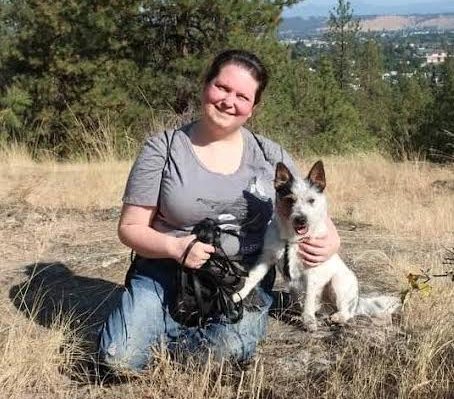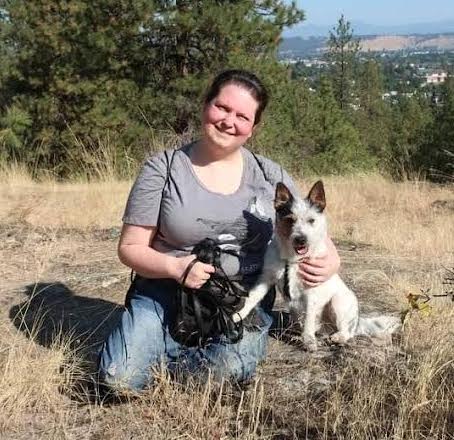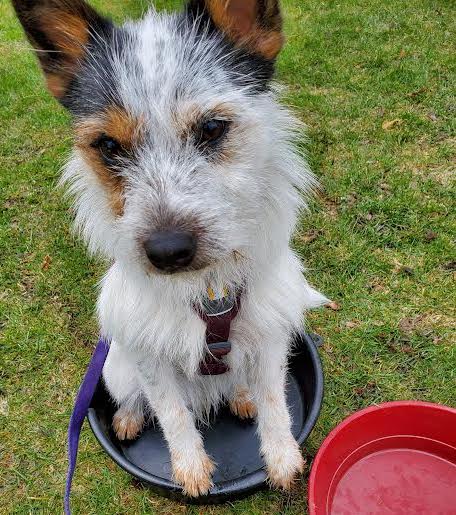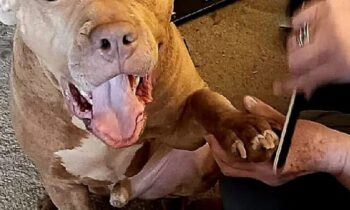

I saw the news on Facebook: a dog trainer in my area has been certified. What does that mean—to her, and to you, if you’re a dog guardian looking for instruction?
I asked a lot of questions—Michelle Brady answered. Here is her story—how she became a certified dog trainer:
Q: Tell us about yourself—where were you born, raised, educated, like that …
Michelle Brady (Spokane, WA) I was born in Mesa, AZ, and lived in Phoenix for the first 12 years of my life. My family then moved to Colorado Springs, CO. My dad suddenly passed away in 2001, a year before I graduated high school, and that put me in a bad place emotionally. I was able to finish high school, but college was a bit too much. I spent my twenties in various retail positions. I lived in Colorado Springs until 2014, when I moved to Spokane, WA, to be closer to my husband’s family.

Photo by Michelle Brady
Q: Did you have pets when you were a kid? Any activities/accomplishments with those pets, like 4H?
I’ve always loved animals. My parents always wondered where my passion came from because they did not share it. That didn’t stop me from having various pets when I was growing up. At first, it was small animals—mice and gerbils—but eventually my mom gave in and I got my first dog when I was eight years old. Her name was Macy because we adopted her in May. She was a young 20-pound mixed breed that was found as a stray. We were visiting Petsmart and the Humane Society had her there for adoption. I pleaded with my mom to take her home and eventually Mom gave in. Recently I asked my mom “Why?” (remember, my parents were not pet people) and she said she saw the bond I had with Macy and there was no question: that was my dog.
Q: Any volunteer activities that involved animals when you were a kid?
I volunteered at Cheyenne Mountain Zoo helping with summer camp during summers. Saturdays, I would go to adoption events at the pet stores to hold adoptable dogs’ leashes and to bring them water.
Q: Any training of your family’s own dog/s? If so, how was that experience for you—and for the dog?
We didn’t do any “formal” training with Macy—the common training method at the time was based on dominance and being the “alpha.” My personality didn’t jive with that, so Macy was left mostly untrained. Our neighbors complained about her barking so she was given a “bark collar” that would first beep, then shock her when she barked. We hated doing that to her, but we didn’t know what else to do. It was only used when we weren’t home, to redirect her. We walked her on a choke chain so she wouldn’t pull; again, we didn’t know a better way. Luckily, she remained a happy sweet dog and lived with us for 14 years before she passed.
Q: What pets have you had as an adult—your first dog, especially?
I’ve had quite a few different pets as an adult, ranging from cats, dogs, birds, fish, reptiles, and tarantulas. I got my first dog a few months after we lost Macy. Her name was Snickers; a three-month-old little black mix that was re-homed to me because she was going to stay small and she was bugging the older dogs in the house. She was a sweet soft soul who didn’t require much training. We lost her to cancer when she was 12 years old. And then there is Kai. He is a 75-pound fluffy mix that was re-homed to me at two-and-a-half years old. The previous owner was completely honest about Kai’s behavior issues, including high anxiety. Kai is the reason I did so much research and really delved into dog training, reading as many books as I could find and joining positive reinforcement groups on Facebook.
Q: Tell us how and why you decided to attend a class or classes with a dog of your own. How was that experience?
Funny story—I didn’t attend a class with my own dog until after I started working for Diamonds in the Ruff. I was nervous about taking Kai into a group class because he is leash reactive. My husband was friends with Carol’s son Travis, but they hadn’t seen each other in a while. During the pandemic they reconnected, and Travis and I started talking about dog training and Kai’s reactivity. When things opened up again in 2021, DITR had lost some of its trainers and Travis invited me to assist classes with him. I jumped at the opportunity. It wasn’t until later that year that I felt comfortable enough to take Kai into a Head Start class. He did amazing with the techniques I had learned about dog management and I had a great time. Kai did not enjoy it as much and was a bit stressed by the class, so we did not continue.
Q: What happened next?!?
After assisting Travis for many months, I started assisting other instructors at DITR and learned the best way to assist. I found myself wanting to demo with the dogs more, and to take on some of the instruction.
Q: When did you first think about being a “dog trainer”? As a kid? As an adult?
As far back as I can remember, I’ve wanted to work with animals in some capacity. As a kid and most of my adult life, though, I felt as if I couldn’t be a dog trainer because I don’t have an “alpha” personality. I didn’t know there was a nice way to train.
Q: What appealed to you about dog training, and why?
Kai really was the catalyst for my giving dog training a chance. With the things I learned via books and online, I found a way to teach that took the dog’s emotions into consideration without being “alpha.” The chance to teach people a kinder, effective way to communicate and connect with their dogs was exactly what I wanted to do. My dream job.
Q: Run through the steps after that AHA! moment when you thought: “I wonder if I could actually do that?”
It started with just assisting Travis one night a week. I was absorbing the material and learning how to manage a class. When more spots opened up for an assistant, I got to work with other instructors who challenged me in different ways. I gained more confidence with time. Then one of the instructors got sick—and left me with instructions to lead the class with Carol assisting. It was the first time I was in charge and I realized this was not only something I could do but something I wanted to do.
Q: Then … how did you get to this whole CERTIFICATION rigamarole?!?
Once I decided dog training was something I wanted to pursue seriously, I knew I wanted to be certified. I knew from talking to other instructors that the CCPDT certification was what I should aim for. I looked up the requirements (had a bit of a heart attack!) and started logging my training hours.
Q: Why is certification important to you?
Anyone can say they’re a dog trainer. What makes me different? Why should someone give me money and trust that I know what I’m talking about? The dog-training industry is completely unregulated and I wanted a way to prove to myself (hello, imposter syndrome) and to my clients that I do know what I’m talking about. I chose the CCPDT® (Certification Council for Professional Dog Trainers®) because it’s well known and the gold standard for certification. The application process is rigorous. To even apply, you must have 300 hours of hands-on dog training within the last three years, and an Attestation Statement from a CCPDT certificant, veterinarian, or other approved professional. Once your application has been approved, you must pass a 200-question exam about learning theory, husbandry, and other dog-related topics. Continuing education is required to renew your certification.
Q: Tell us about Diamonds in the Ruff and what you do there. What are your favorite parts?
DITR offers dog-training classes and private lessons for individuals who want to use positive reinforcement to train their dogs. I am an instructor there and I offer private lessons. I love watching people’s faces light up when their dogs “get it.” When people come into class and can’t wait to tell me how their dog is doing, how much fun training is, or how their dog was able to walk down the street and not have a meltdown. When the scared puppy who couldn’t possibly do anything gains the confidence to come out from under the chair. Seeing everyone’s dogs is definitely a plus.
Q: How did DITR encourage your interest in training and teaching?
Simply put, without DITR, I would not be a dog trainer. From the moment they blindly put faith in me to when I started private lessons, they have had my back. Carol even offered to drive with me to my CCPDT exam. They offered moral support, advice, motivation, and resources to ensure I would succeed. They are excellent at positive reinforcement for dogs, their people, and their instructors. I thrive in that environment.

Photo by Michelle Brady
Q: Tell us about your own pets—especially the puppy! Your goals for the puppy?
I have a bit of a menagerie at my house. My cat Poe has been with me the longest and is now nine years old. My Green Cheek Conure, Willow, was the first pet I clicker-trained. He can spin in circles, jump onto my finger, and give kisses on cue. I also have two lizards, a snake, and eleven tarantulas. There are also my two dogs, Kai and Wasabi. Kai is a homebody and I wanted a dog that would enjoy group classes, dabble in sports, and maybe even be my demo dog. That’s why last year I got myself a puppy and named him Wasabi. He is a “sports mix” and the first dog I got from a breeder. Mini Australian Cattle Dog/Jack Russell Terrier mix (affectionately referred to as a Cattle Rustler). Right now, we do all the things to find out what we enjoy doing together. We take multiple classes a month, including Parkour and Nosework. One thing we are practicing is musical freestyle and we plan to join the Ruff Revue. My ultimate goal is that he can be my training buddy and demo dog.
Q: What are you looking forward to in the near future? Educational opportunities, for example.
Continuing education is extremely important. I look forward to joining the clicker expos and taking more classes. I’m also designing some advanced classes for DITR. Who knows what else the future will hold?
Congratulations to Michelle Brady, certified through the Certification Council for Professional Dog Trainers®!



